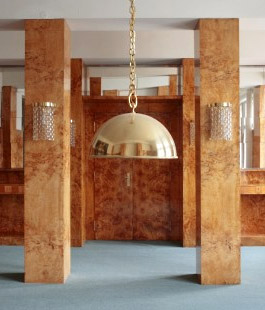
Exhibition at Špilberk maps Loos's work with an emphasis on his hometown Brno
 |
"Here, the architect's work for Brno and for Hrušovany near Brno is detailed, as well as the work of his father, sculptor and stonemason Adolf Loos the Elder, who worked in Brno in the second half of the 19th century," said curator Dagmar Černoušková from the Study and Documentation Centre in Villa Tugendhat to ČTK. Loos's childhood and youth are documented, for example, by school reports and his graduation certificate. "Visitors can see that he was not exactly an excellent student," noted Černoušková.
In addition to photographs, project documentation, and other documents, the exhibition halls of the western wing of Špilberk Castle also feature authentic pieces of furniture, such as armchairs, chairs, and loungers. These are Loos's designs for seating furniture. The architect's distinctive style is illustrated by models of the villa in Hrušovany near Brno, the Konstandt villa in Olomouc, and the Müller villa in Prague.
Indeed, the Müller villa is probably the most famous of Loos's realizations in Czech territory. After reconstruction, it is managed by the Museum of the Capital City of Prague. In addition to Prague, Loos also left other buildings, for example, in Plzeň. In the South Moravian Region, Loos designed, among others, the Bauer villa and a sugar factory in Hrušovany near Brno. He is also the author of modifications to the dining room of the chateau in the Exhibition Centre Brno.
Less known projects that the exhibition presents include the Herold House on Jirásková Street, where Loos made interior modifications and an extension of the garden wing. An interesting fact is the unrealized design for an extension of a house on Sedlákova Street in the Masaryk District of Brno. "In the row house, an apartment for the owner was designed over three levels," said Černoušková.
Loos (1870 to 1933) was born in Brno in a family of stonemasons. His birthplace stood on today's Kounicova Street at the site of the current Continental Hotel. After his studies, he developed a distinctive architectural style that was completely at odds with fashionable Viennese Art Nouveau. In a famous essay, Loos described ornament as a crime, struggling against decorative and ornate Art Nouveau. He sought to achieve a fully functional and practical style.
Contemporary critics said that architects like Loos do not need a pencil - they only need an eraser. The Viennese Café Museum earned the nickname Café Nihilismus due to Loos's austere interior. The Goldman and Salatsch department store opposite Hofburg was dubbed "grain silo" due to its bare facade. Over time, Loos has been appreciated as one of the most significant figures of architectural modernism, standing alongside Mies van der Rohe, Le Corbusier, and Frank Lloyd Wright.
The exhibition on Loos has already had a premier in Prague, as well as a reprise in Italy. "It is now preparing to head to London. We have an offer from Barcelona as well," said the exhibition author Maria Szadkowská. The presentation in the western wing of Špilberk will last until October 24. More information, including details about guided tours and creative workshops, can be found on the website www.spilberk.cz. A catalog is being published for the exhibition.
The English translation is powered by AI tool. Switch to Czech to view the original text source.
0 comments
add comment











